When a 58’ Kady Krogen trawler recently hauled out at Lauderdale Marine Center, our running gear company, High Seas Yacht Service was hired to pull the props and shafts for a routine cutlass bearing and seal service. High Seas Hydraulics was also hired to do routine service on the ABT Trac hydraulic stabilizer systems.
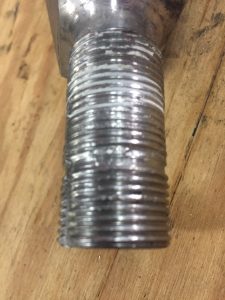
Damaged threads on shaft
Once we dropped the stabilizer fin in order to replace the lower shaft seals, we found the threaded stud on the bottom of one of the shafts was damaged and had signs of thread damage and galling. This was most likely from a stainless steel nut on stainless steel threads that was installed and removed without the proper never seize. This compromised the re-installation of the stabilizer fin nut so we recommended removing the shaft to repair it in our machine shop, Straight Line Marine. Once in the machine shop, we found that the stabilizer shaft was bent 0.080” which is significant for a stabilizer shaft. When we started the straightening process, which involves applying hydraulic force on the high point of the shaft the stabilizer cracked in two. That was a first – never had that happen before. Under examination of the broken ends it is evident that a crack in the shaft had worked its way to 20% through – we just finished off the job.
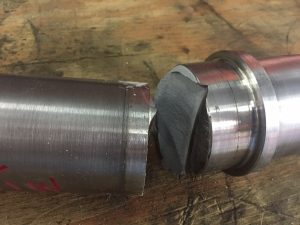
Cracked shaft
This particular vessel is under new ownership so there is limited history as it relates to past problems and repairs. Obviously, this stabilizer was badly damaged at some point in the past. In all likelihood, the boat probably hit something or experienced a hard grounding which lead to a crack in the stabilizer shaft. Over time, these cracks tend to creep and grow.
We were able to source a new stabilizer shaft from the manufacturer and complete the overhaul on the hydraulic stabilizer system.
We have never experienced a stabilizer shaft cracking in two before in our machine shop, but it just goes to show that a small thing such as damaged threads can be a warning sign of bigger issues.





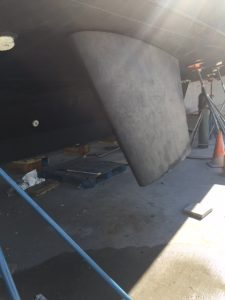 Continuing the work on the 135’ Broward, we have moved on to work on the NAIAD stabilizer system. While NAIAD does not specify an exact interval for performing a major overhaul, it does recommend replacing the lower seals every three years or 4,000 operating hours. Interim service and maintenance should be performed annually but a major overhaul is highly recommended anytime you find water in the grease beyond the outer shaft seals or signs of grease oozing from the inner seals around the shaft. Once salt water compromises the grease the bearings will start to deteriorate and the grease needs to be replaced
Continuing the work on the 135’ Broward, we have moved on to work on the NAIAD stabilizer system. While NAIAD does not specify an exact interval for performing a major overhaul, it does recommend replacing the lower seals every three years or 4,000 operating hours. Interim service and maintenance should be performed annually but a major overhaul is highly recommended anytime you find water in the grease beyond the outer shaft seals or signs of grease oozing from the inner seals around the shaft. Once salt water compromises the grease the bearings will start to deteriorate and the grease needs to be replaced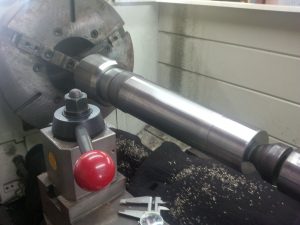

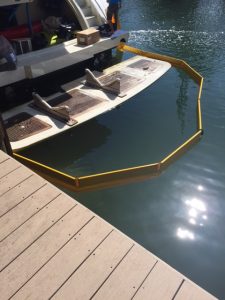
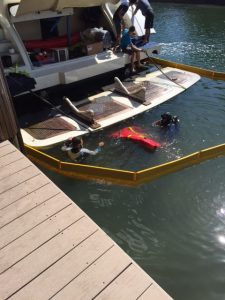
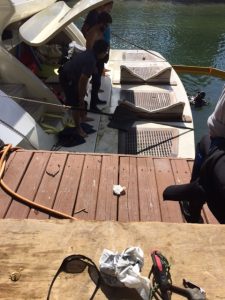
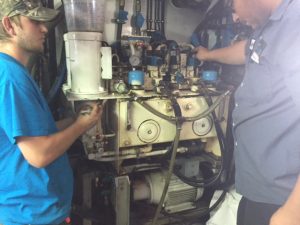 We next disassembled and removed the hydraulic power unit (HPU). The HPU consists mainly of a pair of motors, a reservoir tank and a hydraulic pump. These units can generate a tremendous amount of power to drive most any kind of hydraulic ram. Hydraulic Power Units are based on Pascal’s law of physics, drawing their power from ratios of area and pressure. In this case, the HPU takes the commands from the helm to push the hydraulic rods in the right direction to steer the yacht. A failure of the hydraulic steering system at sea or just about anywhere could prove to be catastrophic.
We next disassembled and removed the hydraulic power unit (HPU). The HPU consists mainly of a pair of motors, a reservoir tank and a hydraulic pump. These units can generate a tremendous amount of power to drive most any kind of hydraulic ram. Hydraulic Power Units are based on Pascal’s law of physics, drawing their power from ratios of area and pressure. In this case, the HPU takes the commands from the helm to push the hydraulic rods in the right direction to steer the yacht. A failure of the hydraulic steering system at sea or just about anywhere could prove to be catastrophic.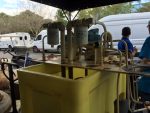 motors out for testing and tested all of the pumps to ensure they were in good working order. We also made all
motors out for testing and tested all of the pumps to ensure they were in good working order. We also made all